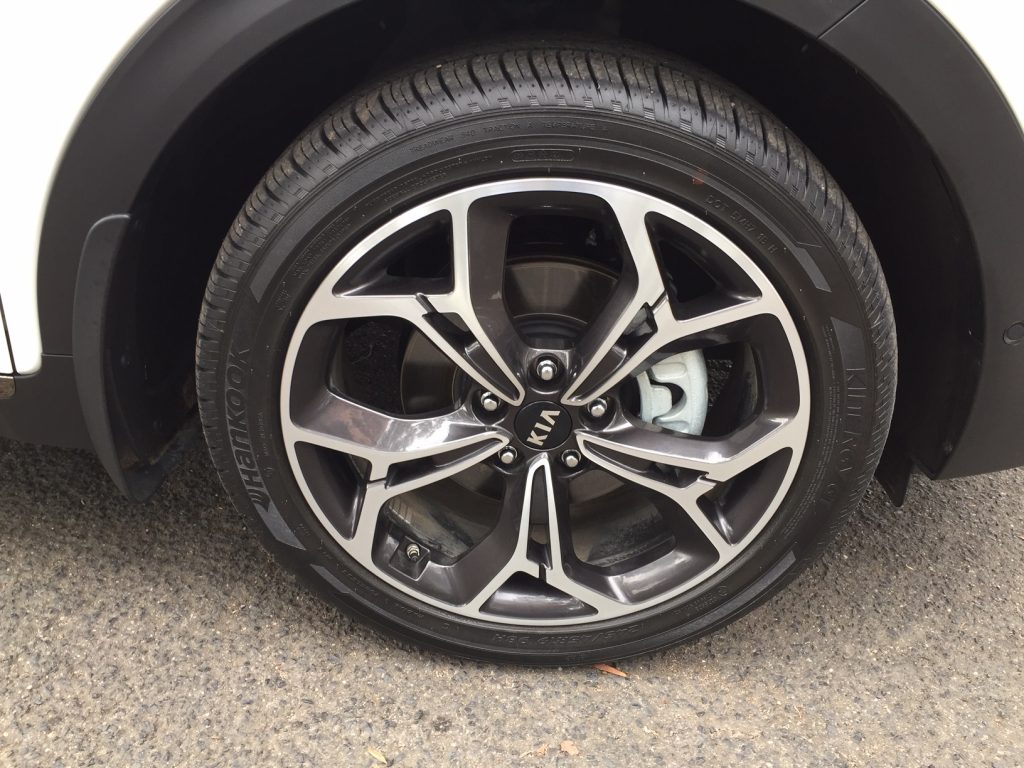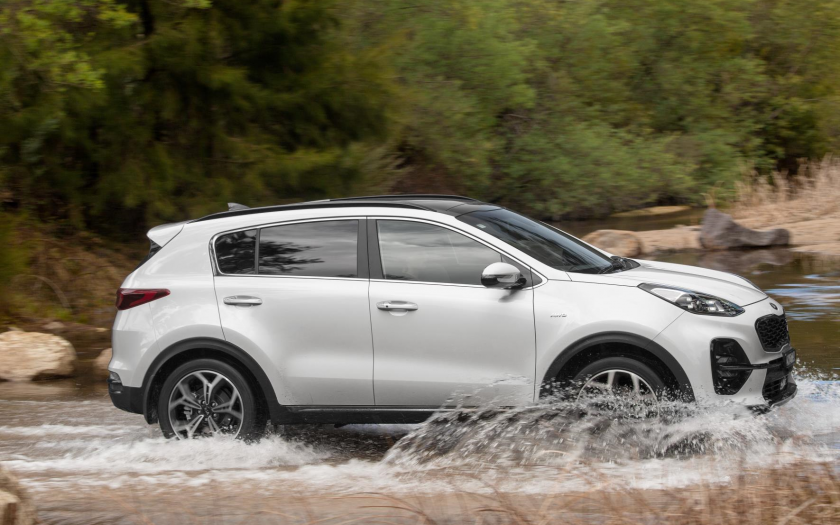Ian Crawford tests the 2019 Kia Sportage GT-Line with pricing, specs, ride and handling, safety, verdict and everything the over-50 driver needs to know.
Summary: The Kia Sportage competes in Australia’s most competitive segment. It ably demonstrates why Kia is rocketing up the sales charts and winning converts left, right and centre.
2019 Kia Sportage GT-Line
Pricing: $29,990 (2-litre petrol Si) up to $47,690 (GT-Line diesel) plus on road costs. $44,790 (GT-Line 2.4-petrol, as tested). All prices plus on-road costs.
Warranty: 7-years, unlimited kilometres (still the best around)
Safety: 5-star ANCAP (tested 2016)
Engine: 1999cc petrol four-cylinder (Si, Si Premium, SLi and GT-Line), 2359cc petrol (GT-Line only), 1995cc diesel (all models)
Power: 114kW @ 6200rpm (2-litre petrol), 135kW @ 6000rpm (2.4-litre petrol), 136kW @ 4000rpm (2-litre diesel)
Torque: 192Nm @ 4000rpm (2-litre petrol), 237Nm @ 4000rpm (2.4-litre petrol), 400Nm @ 1750-2750rpm (2-litre diesel)
Transmission: six-speed automatic (petrol) eight-speed automatic (diesel)
Drive: front wheel drive (Si), all-wheel drive (other models)
Body: 4485mm (L), 1855mm (W), 1655mm (H)
Minimum ground clearance: 172mm (a little more wouldn’t go astray for an SUV)
Tyres: 225/60 R17 (Si), 225/55 R18 (Si Premium, SLi), 245/45 R19 (GT-Line)
Boot capacity: 466 litres to 1455 litres
Weight: 1532-1736kg
Turning circle: not stated
Towing: 1600kg (2-litre petrol, braked), 1500kg (2.4-litre petrol, braked), 1900kg (2-litre diesel, braked), 750kg (all, unbraked)
Spare: full size alloy (well done, Kia. “Space saver” spares and “repair kits” are penny pinching)
Fuel tank: 62 litres
Thirst: 8.5L/100km (2,4-litre petrol, combined, 91 RON), 7.9L/100km (2-litre petrol), 6.4L/100km (2-litre diesel)
seniordriver consumption: 10.3L/100km (Mr Crawford neglected to tell us how far he travelled)
[review]
WHEN A CAR COMPANY chooses to play in the Australian market’s most-competitive segment – the under-$60,000 medium SUV category – it had better do things pretty well.
In the case of Kia’s Sportage, it does just that.
The segment in question is the medium-SUV category and with around 25 brands and umpteen model variants from which to choose, local buyers have never had it so good.
Until the recent arrival of the new Toyota RAV4, Mazda’s CX-5 had not only been the medium-SUV king, it was also Australia’s biggest-selling SUV across all categories.
In the July VFACTS report, the medium-SUV sales pecking order was RAV4, CX-9, Nissan’s X-Trail, the Hyundai Tucson, Subaru’s Forester, the Mitsubishi Outlander with Kia’s Sportage coming in at seventh.
Despite that result, the Sportage does things exceptionally well, without setting the sales charts on fire. (Which, to be honest, we find a little hard to understand – Editor)
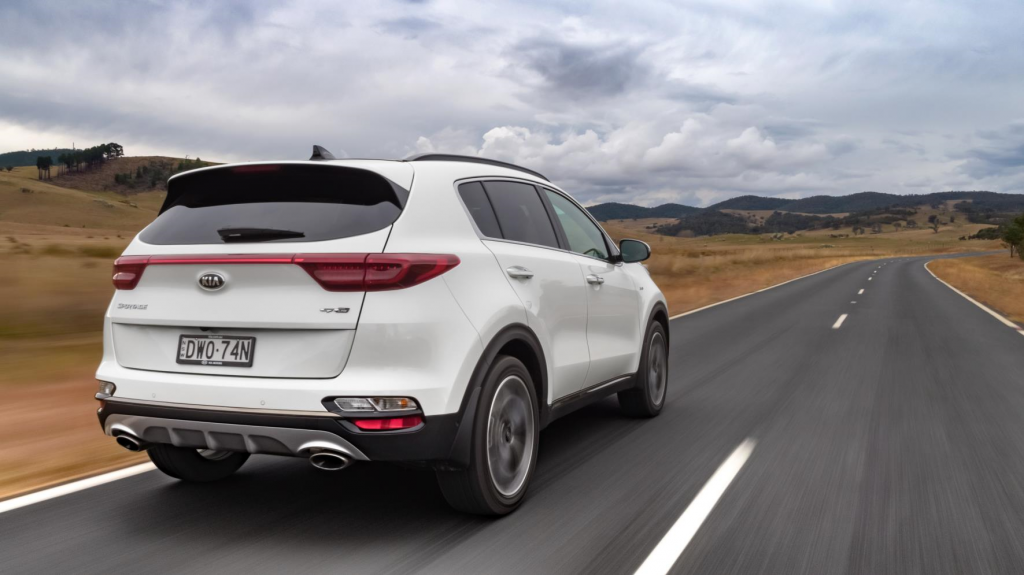
Four models, three engines
Available in four guises – Si, Si Premium, SLi and GT-Line – buyers have the choice of petrol or diesel engines and depending on the model, either a 114kW/192Nm two-litre engine or a 2.4-litre unit with 135kW/237Nm.
The excellent two-litre oiler is good for 135kW of peak power and a thumping 400Nm of maximum torque.
While the petrol engines are mated with a six-speed torque-converter automatic, the diesel is hooked up to a great eight-speed auto.
In terms of range pricing, the Si two-litre petrol opens the batting at $29,990 and the range-topping GT-Line diesel burns a $47,690 hole in the cheque book.
For this review, the second-from-the-top GT-Line petrol was the vehicle of choice and it comes in at $44,790.
The current Sportage generation arrived in dealer showrooms about a year ago and Kia was pretty chuffed about the addition of autonomous emergency braking and lane-keep-assist across the range.
Ride and handling were also improved –thanks to Kia’s long-standing commitment to local testing and refinement – and the great eight-speed automatic transmission was bolted on to the diesel engine.
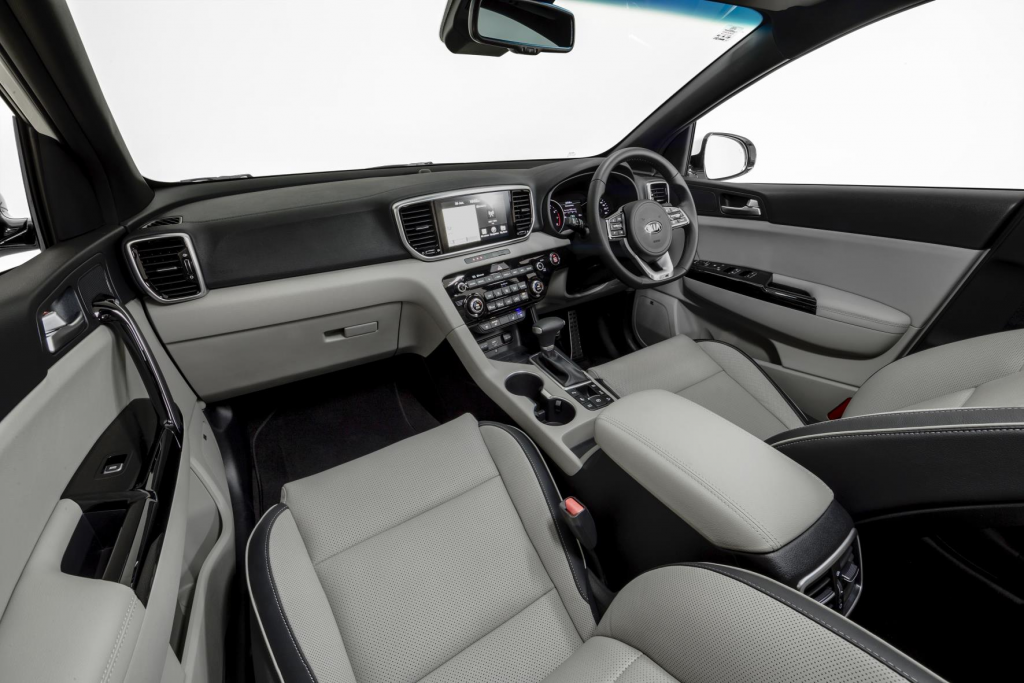
Kia interiors continue to improve
Climb in behind the wheel of the GT-Line and you are immediately stuck by the quality feel and ambience of the cabin.
The colour treatment is very much two-tone with a classy blend of light and dark-grey leather and plastic – most of which is the nice soft-touch variety.
The controls are very much driver-focused, and the ergonomics are just right.
The well-shaped and bolstered front seats are beautifully comfortable and supportive and to add to the luxury, they are both heated and ventilated.
Other luxurious features are the Sportage’s huge standard panoramic sunroof, a great-to-hold, leather-wrapped, flat-bottomed, multi-function sports steering wheel with shift paddles and a smart power tail gate.
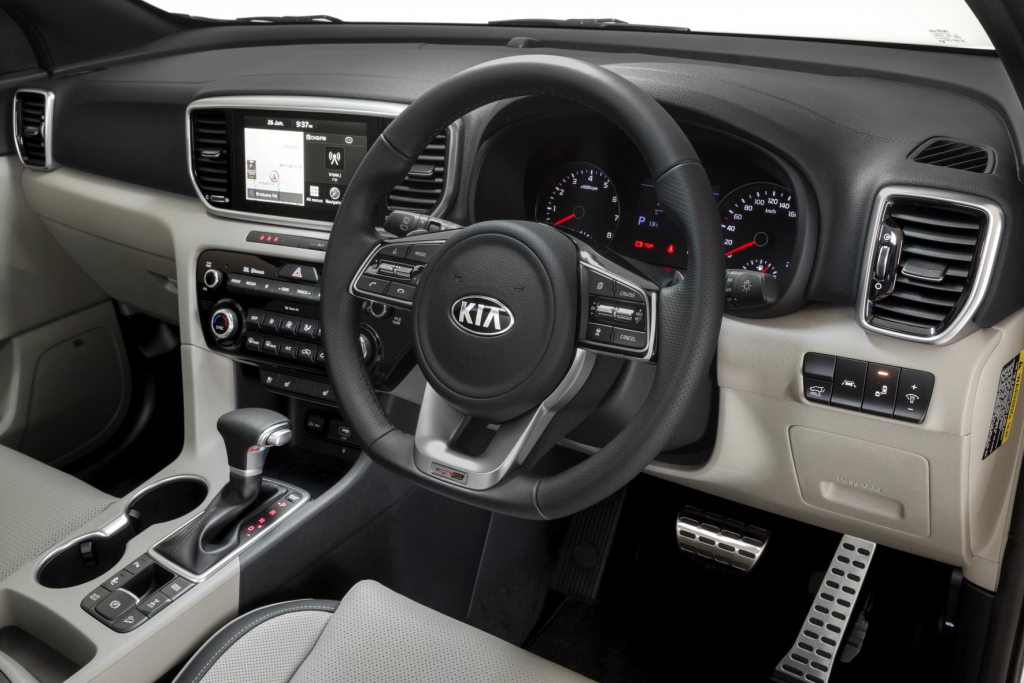
No shortage of standard equipment
Looking down the extensive standard-kit inventory is quite exhausting.
How’s this for a menu?
- AEB with forward collision warning,
- lane-keep assist,
- high-beam assist,
- blind-spot monitoring with rear cross-traffic alert,
- a rear-vision camera with those clever dynamic guidelines,
- an eight-way powered front-passenger seat (10 ways for the driver),
- wireless phone charging,
- LED fog lights,
- LED headlights with automatic levelling,
- 19-inch alloys shod with 245/45/R19 rubber
- and advanced smart cruise control.
And that’s just the start.
Add a dash-integrated eight-inch LCD touch screen, Apple CarPlay and Android Auto, an electronic parking brake and a few other goodies and there’s no doubting that the top-spec Sportage can just about out-do anything else in the segment in terms of its standard kit.
In the safety department, there are also driver, front-passenger, front side and curtain airbags and these and all the other safety kit helped the car achieve a five-star ANCAP rating during 2016 crash testing.
We’re already mentioned the comfort of the front-seat occupants and this is carried over to those in the second row.
The 60/40 split seat backs can be reclined and when the seats are occupied, there is room for 466 litres of luggage. Drop the seat backs flat and this rises to a handy 1455 litres.
Other cargo-handling features include grocery hooks, tie-down latches and a luggage net.
Cabin storage features include two front and two rear cupholders, four door pockets, a handy roof-mounted sunglasses holder, map pockets behind the front-seat backs, a reasonable-sized glove box, a good-sized bin beneath the front-centre armrest and a couple of open bins on the centre console.
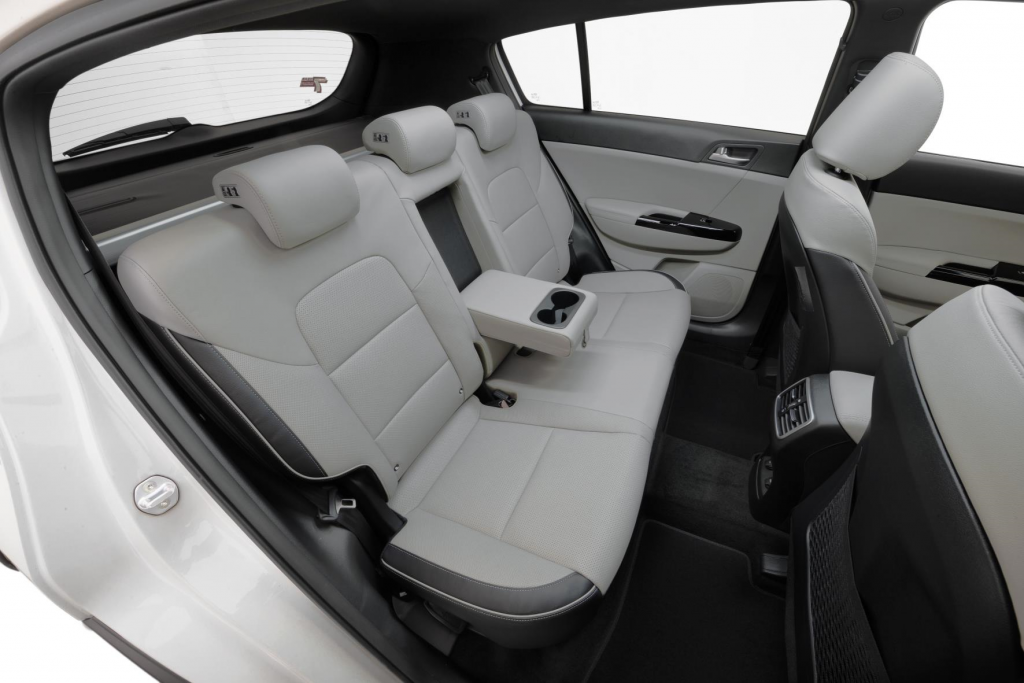
Good performance for the real world
While the 2.4-litre petrol engine doesn’t set the world on fire and, like all four-cylinder petrol engines it does scream somewhat when the revs approach the limit, it will do a perfectly adequate job for most buyers.
Out on the freeway at cruising speed the Sportage loafs along extremely comfortably and the Australian-tuned suspension handles less-than-smooth road surfaces without any fuss.
On corners the car sits nice and flat and the steering is well weighted and responsive.
The automatic – while not in the same league as the diesel’s eight-speeder – mates successfully with the “four” and the paddles add to the driving fun, especially on hills and winding roads.
While Kia claims a combined fuel-consumption figure of 8.5L/100km, we saw 10.3L/100km during two weeks of city, suburban and country driving – all on bitumen.
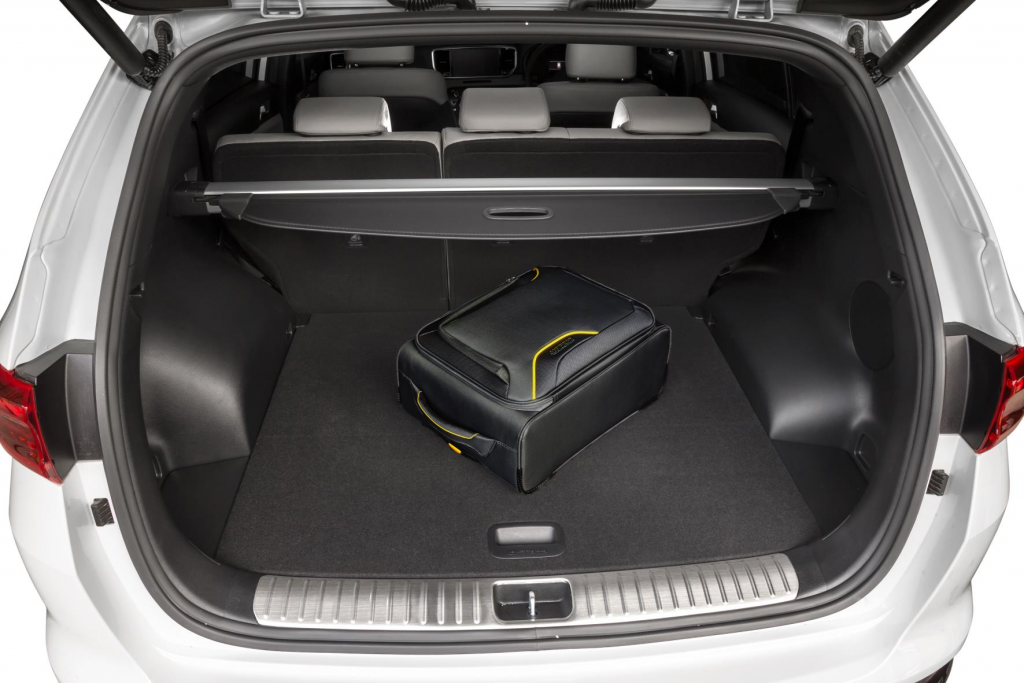
So much to like
In summary, the things we like include the generous standard-kit inventory, the classy interior, the full-size spare and that great Kia warranty.
There’s not much to dislike about the GT-Line but a couple of niggles are no memory for driver’s seat and the fact that the engine is a bit thirsty.
Kia’s success in the Australian market (and world-wide for that matter) in recent years has been nothing short of remarkable.
Five years ago, if someone had told me the company would be outselling Holden in 2019, I would have laughed at them.
It all comes down to great styling (started by master designer Peter Schreyer), build quality, generous standard equipment, safety and caring enough about the local market enough to undertake extensive ride-and-handling tuning right here in Australia.
There is no doubt that cars such as the Sportage, its little brother the Picanto and its Sorento and Carnival big brothers – not to mention the stunning Stinger – will see the brand go from strength to strength.
